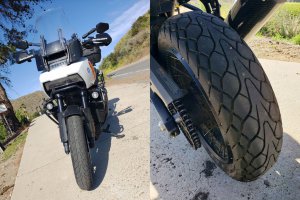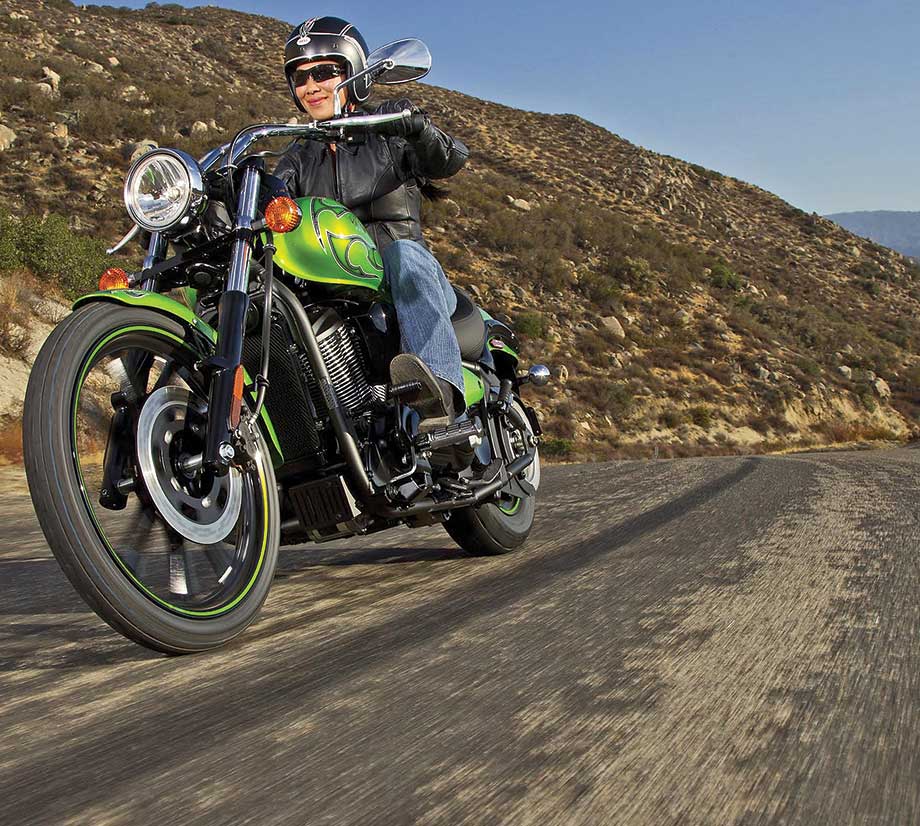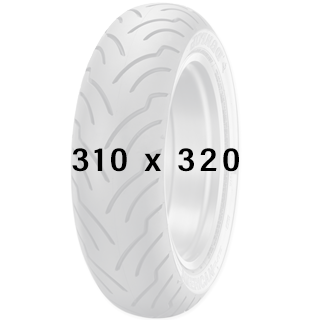What Does the Size of the Motorcycle Tire Mean for My Ride Experience?

Tire sizes vary widely. Yet, for street, sports touring, and sports bikes, the general guide is the bigger the tire, the more grip. Front tires, though, have their own set of rules. Street bikes and sports tourers hover around 17-19″. Meanwhile, sports bikes such as the Suzuki GSX 750 R, Honda CBR1000RR, and Yamaha R1 run 17″ wheels.
As for custom motorcycles, only the imagination limits a tire’s size. Front tires can reach a diameter of 23″ and the largest current rear tire is a monster 360/30-18″, at over 12″ wide.
Tire sizes are meaningless unless you are aware of how a motorcycle’s tire size affects the quality of your ride. So read on and get the low-down on tire sizes.
Why increase the width of a rear tire?
Almost every component you add to your motorcycle can affect its handling. Wide tires can improve pavement grip. The trade-off, though, is the motorcycle wouldn’t turn as easily because of the wider footprint.
Increasing the size of a rear tire is not something to undertake lightly. There are several factors to consider, but more on those later.
Today, we see the 18″ rear tires of 70s sports bikes replaced by smaller diameter, extra-wide tires. This increased footprint allows for faster take-offs. For a sports bike, it also provides improved cornering stability.
A wider footprint on a sports tourer increases load-bearing. The reason for this is improved weight distribution. What’s more, it is also a softer ride.
As for cruisers, the popular ‘”Phat” look has owners and some manufacturers fitting oversized rear tires to their motorcycles. Some argue that this feature smoothes out the bumps on bikes with limited suspension. The actual reason, though, is often cosmetic.
What happens when you fit a different size rear tire?

Fitting a wider rear tire is not as straightforward as it may sound. The first thing to consider is whether the swing-arm setup can accommodate the extra tire width. Next, and just as necessary, is ensuring the tire doesn’t interfere with the alignment of the drive chain. Last but not least is to budget for the possibility of a different rear fender and chain guard. You may also need sprocket spacers to accommodate the extra width.
A bi-product of a wider rear tire is that the engine will have to work a little harder to achieve the same performance compared to a stock tire. This fact is that some riders prefer slimmer tires because it allows the engine to run without bogging down.
Finally, if you increase the tire height, you are altering the gearing because the smaller rear tire is rotating faster.
What happens when you fit a different size front tire?
Fit a wide front tire, and the handling may be smoother. Also, there will be a tendency for the bike to roll into the bends. Moreover, grooves and tar snakes on the road are less likely to affect a wide front tire. It will also handle uneven surfaces better.
The downside is decreased steering feedback and a slight feeling of vagueness. The vagueness is caused by the wider tire dampening out imperfections in the road. If the size increase is significant, you may need to replace the front mudguard and the hub and brake caliper, may require spacing.
Fit a narrow profile front tire and the steering will be sharper, but the tire will be more inclined to follow longitudinal road imperfections. The tire’s lack of shock-absorbing power also means the rider can readily feel more bumps through the handlebars.
In both cases, replacing the stock item with a taller tire alters the speedometer reading on an analog instrument.
As a basic principle, if you increase the width of a front tire, you will also need a wide wheel. By doing so, you add unsprung weight, meaning the steering becomes heavier. The opposite is true with the lighter wheel and tire with a narrow front tire, making the steering quicker.
Different sizes for different bikes

Motorcycle manufacturers go to great lengths to design optimum wheel and tire sizes for stock bikes.
Like all motorcycle developments, tire/wheel sizing advances for best performance come straight from the track, whether smooth tarmac or rutted dirt.
In the case of sports bikes like the Yamaha R1, although the rear tire is a lot wider than the front, both wheels have a diameter of 17″. This configuration gives the best feedback and stability on the front. It also improves grip and cornering ability on the rear.
When we come to show motorcycles, the size differential between front and rear becomes pronounced. Here, performance gives way to aesthetics.
For example, Harley-Davidson’s ‘Breakout’ model uses a wide 240/18″ rear combined with a 130/21″ front. This accentuated fat rear and the skinny front combination produces a slow and ponderous back end. Its steering is light and twitchy due to the vastly different tire footprints.
There are few reasons to change the front or rear tire size on a modern street, sports, or touring motorcycle for performance gains. You can also say the same for off-road bikes. It’s only the custom bike world where changing the tire size remains a regular occurrence.
There are exceptions, though. Not all custom builds follow “chopper” rules for wheel sizing. Street Tracker, Brat, Supermoto, and Cafe Racer conversions will often see tire size changes to enhance performance.
Whatever tire size combination you choose, always seek the advice of a motorcycle tire professional. You can find your nearest Dunlop Motorcycle Tire dealer by clicking here.









